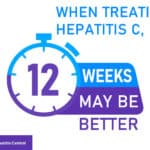New Method for Improving HCV/HIV Co-Infection Response
Weight-based ribavirin dosing achieves high success rates in hepatitis C/HIV co-infected patients
Gus Cairns
aidsmap.com
Increasing the dose of ribavirin in interferon/ribavirin therapy and basing it on the patient’s weight can achieve impressive treatment success rates, approaching if not yet equaling those seen in HIV-uninfected patients, Spanish researchers reported last week.
Study results from the PRESCO trial of pegylated interferon and eight-based ribavirin were presented by Vincent Soriano to the Eighth Glasgow International Congress on Drug Therapy in HIV Infection in Glasgow.
PRESCO is a trial of hepatitis C (HCV) therapy in reasonably well patients: participants had to have a CD4 cell count of over 300 cells/mm3, were not allowed to take AZT (zidovudine, Retrovir) or ddI (diadosine, Videx) and were not cirrhotic. It was an open-label study, with no comparison with other regimens.
The study gave patients 180 micrograms of pegylated interferon alfa-2a (Pegasys) per week and combined it with a daily dose of either 1000mg ribavirin if the patient weighed less than 75kg or 1200mg if they weighed more.
The original PRESCO protocol, devised in December 2002, prescribed 48 weeks of treatment for patients with genotypes 1 or 4 of HCV and 24 weeks for genotypes 2 or 3. However after the APRICOT study results came out, this was amended in August 2004 to allow 72 weeks of treatment for genotypes 1 or 4 and 48 weeks for 2-3.
In the end 192 patients with genotype 1/4 took 48 weeks of treatment and 45 for 72 weeks. Ninety-six patients with genotype 2/3 took treatment for 24 weeks and 56 for 48 weeks.
Presenter Vincent Sorriano commented that it had been difficult to persuade patients to extend their treatment period and results were “hampered by voluntary withdrawal”.
The Sustained Viral Response (SVR) rates were 49.6% for all patients, 35.6% for genotype 1, 32.6% for genotype 4 and 72.4% for genotype 3 – there were virtually no genotype 2 patients in the study.
Extended treatment did convey additional benefit. SVR results for patients with genotypes 1/4 were 53% for patients who took treatment for 72 weeks and 82% for patients with genotypes 2/3 who took 48 weeks of treatment.
Hepatitis C treatment can appear to be successful, with undetectable HCV viral loads at the end of treatment, but it can then relapse and HCV can reappear, which is why the SVR is measured twelve weeks after the end of treatment and is the measure of treatment success. The relapse rate for patients with genotype 1 was 35% and with genotype 4 was 20%, with few relapsers for genotypes 2/3.
About a third (34.6%) of patients discontinued their treatment with 8.2% doing so for adverse events and 16.4% withdrawing voluntarily. About 15% of patients had their interferon dose reduced for toxicity and about 20% of patients had their ribavirin dose reduced.
The dose-limiting toxicity of ribavirin is usually anaemia. Four had to stop treatment at twelve weeks for this reason, four at 24 weeks and one at 48 weeks.
There was one death attributed to treatment in the trial – a patient who committed suicide, presumably due to the depression which is a notorious side-effect of interferon.
Sorriano contrasted his trial results with those from two previous trials: the APRICOT trial (Torriani), which is the largest study ever conducted in HIV/HCV co-infected patients but used an 800mg fixed dose of ribavirin, and the PISG trial (Fried) which used weight-based ribavirin but in monoinfected patients.
Sorriano said that PRESCO was the largest trial using weight-based ribavirin conducted in co-infected people so far and said that his results justified using this approach in future.







